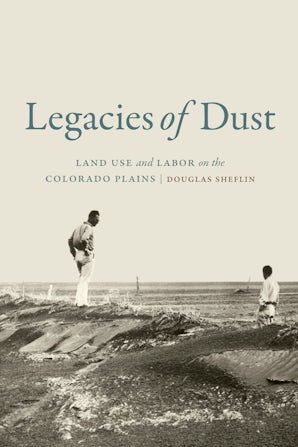"The discussion of the environment and migrant labor in the decades after the Dust Bowl distinguishes this volume from others on the subject and broadens its importance beyond the regional."—C. K. Piehl, Choice
"Sheflin has written a perceptive, smart, and solidly researched history that informs us about the Colorado Dust Bowl. . . . It is a transformative story of the federal government’s influence on the agriculture, demography, politics, and labor of the region."—R. Douglas Hurt, Journal of Arizona History
"A highly informative study for students of agricultural history."—Lynn Bueling, Roundup Magazine
“Legacies of Dust offers a significant new interpretation of the Dust Bowl. Douglas Sheflin’s long-term analysis of the Dust Bowl’s impact is this book’s most distinctive and important contribution. And his investigation of the direct and indirect impacts of the Dust Bowl and the New Deal on the agricultural labor force in the 1930s, 1940s, and 1950s is especially pathbreaking.”—Brian Q. Cannon, professor of history and director of the Charles Redd Center for Western Studies at Brigham Young University
“While both popular and scholarly accounts of the Dust Bowl confine it to the 1930s, this careful and authoritative reconstruction of southeastern Colorado provides a much longer time frame for assessing two pivotal processes of the 1940s and 1950s: how farmers adopted a new and largely effective set of soil and water conservation practices and how the region came to depend on a labor regime of migratory workers. Sheflin deftly threads an analysis of the Dirty Thirties together with the broadest questions of postwar agricultural history.”—Sarah T. Phillips, associate professor of history and director of graduate studies at Boston University
“This is a serious and thoughtful history of Colorado agriculture. The way it mixes environmental, political, and labor history is always interesting and sometimes downright poetic. The material on migrant children is important and absolutely fascinating.”—Jonathan Rees, professor of history at Colorado State University at Pueblo
“Douglas Sheflin’s new, exceptionally well-researched study of the legacy of New Deal, Dust Bowl policies in southeast Colorado, convincingly reveals how the combined work of the Colorado Extension Service, the Social Conservation Service, the Production Management Administration, and Soil Conservation Districts rectified the unsustainable production-first mentality of farmers in the 1920s. As a result, Sheflin clearly illustrates how these policies produced for farmers a federal safety net well beyond the 1930s, especially for those who practiced soil conservation.”—James E. Sherow, University Distinguished Professor at Kansas State University
